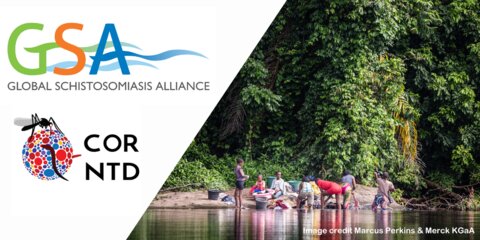Elimination of Schistosomiasis as a Public Health Problem. Experiences on reaching the goal and what to do next from endemic countries.

COR NTD and the Global Schistosomiasis Alliance (GSA) are pleased to announce a pre-meeting session:
"Elimination of Schistosomiasis as a Public Health Problem – Experiences on reaching the goal and what to do next from endemic countries."
- Date: October 7, 2020
- Time: 07:00 EDT (Atlanta)/ 11:00 GMT / 12:00 BST (UK) / 13:00 CAT (Malawi) / 14:00 EAT (Ethiopia and Tanzania)
Session Aim:
In 2013 the WHO published thresholds for achieving control of morbidity as less than 5% prevalence of heavy intensity and less than 1% prevalence of heavy intensity for achieving elimination as a public health problem (EPHP) for schistosomiasis. This latter threshold has been maintained within the WHO’s 2030 Roadmap but with the caveat that, a critical action is to ‘Define (an) indicator for measuring morbidity towards elimination as a public health problem’. Published evidence (Deol et al 2019, Weigand et al (to be submitted) and SCORE) observes that where NTD programmes are reaching this EPHP threshold there could still be significant morbidity within communities. In addition, the correlation between intensity (which goals are based on) and prevalence (which preventive chemotherapy (PC) decisions are based on) is not clear, especially after multiple rounds of PC .
The session will provide the opportunity for NTD programmes in Ethiopia, Malawi and Tanzania to share evidence on achieving EPHP for schistosomiasis and what their current intervention decisions are when the target has been achieved.
WHO 2019 fact sheets indicate population requiring MDA in Ethiopia, Malawi and Tanzania is 13,517,476; 9,677,847; 14,736,305, respectively, however it is unclear what proportion of this population have no acute or reversible schistosomiasis related morbidity. Are the current intervention decisions in these three endemic countries to maintain ‘business as usual’ annual/biennial/triennial PC based on prevalence; or are these countries adapting PC and other interventions having reached the EPHP threshold?
The session will then aim to generate, from a programme perspective, what the main facilitators and barriers are to make these post-EPHP-target intervention decisions. The session will then formulate the key operational research questions on what interventions are required to maintain these achievements, what more is required to reduce morbidity further and what is required should countries choose to proceed to interruption of transmission? It also will enable development of OR questions from programmatic perspective hence feed an M&E framework.
Agenda:
Part 1 Talks (60 mins):
- Welcome and overview (Upendo Mwingira, Fiona Fleming, Chelsea Toledo – 5 min)
- Pauline Mwinzi: : SCH 2030 Roadmap indicators and regional progress, (WHO/ESPEN) (10 min)
- Lazarus Juziwelo: Reaching, maintaining and going beyond the EPHP goal for Schistosomiasis in Malawi (10 min)
- Fikre Seife: Reaching, maintaining and going beyond the EPHP goal for Schistosomiasis in Ethiopia (10 min)
- Dennis Kailembo: Reaching, maintaining and going beyond the EPHP goal for Schistosomiasis in Tanzania (10 min)
- Charlie King: Challenges of using intensity of infection as a measurement of EPHP (10min)
Part 2 Parallel break-out discussions (40 mins):
- Group A - What is EPHP and what do you do once you have achieved the target (as it is currently defined)? What are the OR questions that need to be addressed?
- Group B - What intervention strategies are required for communities where EPHP (as it is currently defined) has not been achieved e.g. where prevalence may be low but there are still high infection intensities? What are the OR questions that need to be addressed?
Part 3 Final Plenary (20 mins):
Return from break-out groups into main group and report by chairs and rapporteurs of discussion results and key operational research questions identified.









